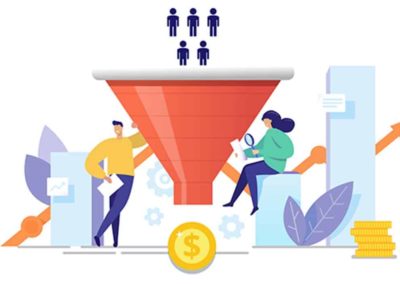If you’ve ever been on the receiving end of a sales call, you’re probably used to hearing the same sales tactics. When outright selling to you doesn’t work out, salespeople will often resort to calling you repeatedly (even if you said no outright), becoming semi-aggressive, or attempting to persuade you by offering a “special deal.” The reality is these sales tactics are tired and, worse than that, predictable. That’s why you can’t underestimate the power of the unexpected when it comes to boosting your sales team with these sales strategy examples.

What Is ‘The Expected’?
In sales, there are a few common sales strategy examples that salespeople have been using for years that prospects have come to expect. Some of them include:
- Trying To Instill FOMO (Fear Of Missing Out) In A Prospect
- “If you don’t secure this product for your company now, you’re going to be setting yourself up for failure and will miss out on some major growth opportunities.”
- Creating A False Sense Of Urgency
- “I can only offer you this deal for the next 10 days, but after that, it’s going to be gone forever.”
- Bringing Up Your Competition
- “You know, I was speaking with Clyde Barnes down the street yesterday and he seemed very interested in this product. Since he is your competition, I would only feel comfortable working with one of you. I wanted to give you the opportunity to sign a contract with us first before I reach out to him again.”
- Trying To Undermine Your Current Partners
- “Your current [marketing/CRM/design] company just isn’t well respected in the industry. I know you’re friends with the owner, but such a small brand simply can’t offer the same features that we can for the price we are quoting.”
- Trying To Undercut Your Current Partners
- “We will offer you the same service for 75% of the price your current partner is charging.”
- Dropping Names
- “We’ve worked with big-name retailers like [insert retailer name here], and they have been very happy with our service. We can offer you that same luxury service for a fraction of the price. Would you like to see some of their success stories?”
- Attempting Flattery
- “I know that with your background and experience in this industry, you’re going to be able to see what a high-value deal this is.”
- Undercutting A Prospect’s Authority
- “Well, I’d still like to speak to your supervisor. I know with her background, she will be able to see the long-term value in this revolutionary product.”
There are more common strategies and tactics than the ones listed above, but these are some of the most notorious.
So what’s wrong with these sales strategies?
While some of these tactics can be effective in certain situations, they have several fatal flaws. Firstly, they are so common that prospective buyers have come to expect them and are desensitized to them. Secondly, they have the potential to appear incredibly manipulative, pushy, and disrespectful. As you can imagine, being rude is no way to start a relationship with anyone, least of all someone that you’re hoping to convince to bet their hard-earned money on your ability to deliver results.
So how can you stand out? Here are some sales strategy examples that will change the game.
Knowing Your Customer
Often salespeople fall into a rut of using a “one size fits all” approach when it comes to sales. But just like one pair of pants won’t fit every person, one sales strategy isn’t going to fit every potential buyer. Your sales team needs to tailor their approach for each individual prospect — and that starts with knowing their personality type.

A DISC profile is a great way to get a basic understanding of your potential customer’s personality type. This assessment can be taken by anyone and lets you know whether a person is primarily led by dominance, influence, steadiness, or conscientiousness when making decisions. However, as you can imagine, you’re not going to have outright access to your lead’s results while on a sales call. So how can you get a good idea of where they fall?
The easy answer is that you’re going to have to code your interactions with your prospect and take note of how they respond to questions and statements. While not a foolproof method, this is a good way for your sales team to get good at reading people and adjusting their behavior to persuade different personality types. This method takes a lot of practice, but once you have a solid grip on it, selling will become much easier.
‘Are You Mad At Me?’
Your potential buyers are probably expecting a predictable outcome when they answer a call from you. They likely suspect that you will immediately launch into trying to sell them a product or service, and because of this, they might already have walls up that are not conducive to having a productive interaction.
What they’re not expecting is for you to ask a question like, “Are you mad at me?”
This question tends to immediately put prospective customers off-guard and invites them to have a more personal conversation with you. You should always follow it up with one of the following statements, or something similar.
- “I know that we didn’t get a chance to catch up about your interest in [X product], and I apologize for that. I hope you’re not too upset with me.”
- “I meant to send you an additional email with more resources about [X product], and I didn’t get around to it. I can send it over now if you like. I hope you’re not too upset with me.”
- “I was hoping to get back to you last month to learn more about your business process, and it seems that time got away from me. I hope you’re not too upset with me.”
This statement is especially effective if you have actually forgotten to follow up with a prospect (which you should try to avoid doing as much as possible). But it’s also effective for more dominant buyers who like to feel like they are in control of a situation. Even if you are not at fault, asking this question will make them feel like they have more of a say in your process and put them more at ease.
A question like that also invites the prospect to be more open with you because it humanizes you. The fact that you are stating that you are concerned about their opinion of you and how you are perceived speaks volumes about your character and will differentiate you from other salespeople they have spoken to.
Get Familiar
People are more likely to trust people they like, and they are more likely to buy from people they trust. So while, yes, a sales call is primarily about trying to make a deal, don’t be too rigid with that goal. Get familiar with your potential buyer. Ask about their hobbies, interests, and tastes. If you can find common ground, that’s all the better. Spend time building real person-to-person rapport with your leads, and over time, they might even start to look forward to hearing from you. This will set you apart from the competition, who is likely calling with only selling in mind and is not interested in getting to know the person they are talking to.

“Are You Telling Me To Get Lost?”
Oftentimes prospects will give a soft “no” to salespeople to avoid seeming impolite, even if they have no intention of ever buying from them. They would rather say “no” indirectly 10–15 times than to outright say “go away” the first time. This passive “no” can have a lot of variation. Here are some of the most popular statements.
- “Unfortunately, that’s not in the budget for this quarter.”
- “We’re all set for marketing right now. Maybe some other time.”
- “We already have a CRM right now, but maybe in the future …”
- “I can check with my supervisor, but they’re probably not going to go for it.”
- “I’m sorry, I can’t authorize that, and my supervisor is on vacation/in a meeting/not accepting new calls.”
- “I can ask my team and get back to you.” (They will never get back to you).
- “I’m a little bit too busy to give this my full attention right now. Can you just send me an email?”
- “I don’t know. Send me the details by email, and I will think about it.”
- They don’t answer your calls, emails, or voicemails at all.
Getting variations of “no” like this can be frustrating because they leave you unclear on where you stand. Is the person really going to ask their supervisor? Are they really open to hearing another pitch next quarter? Instead of continuing to call these prospects hoping to get an answer, try this.
After the third time that a prospect gives you a soft “no,” ask, “Are you telling me to get lost? If so, just let me know, and I’ll get out of your hair.” This strategy, while bold, has three key effects that can seriously elevate your sales calls.
Firstly, most people are not rude enough to tell you to “get lost.” Phrasing the question in that way means that if they want to tell you to leave them alone, they’re going to have to admit that they do, indeed, want you to hit the road.
Secondly, this openness can be refreshing to prospects who are used to pushy salespeople calling again and again when they feel they have made it clear that they are not interested. Saying that you will respect their boundaries is likely a breath of fresh air. At the very least, it will make you more memorable.
Thirdly, if leads do genuinely want you to leave them alone, this gives them a chance to give you a direct answer instead of a passive one. Why waste time and energy on a lead that has no intention of ever buying from you? Wouldn’t you rather know that they are genuinely not interested?
It should be noted that if you’re going to ask this question, you need to do so in a tone of voice that suggests that you are worried you’re bothering them. If you ask these questions aggressively or in a way that suggests they have wasted your time, you will appear incredibly rude, and you can kiss any positive feedback or potential future business from that person goodbye. This is an advanced technique, and we don’t suggest using it if you’re not confident in your ability to convey an air of friendliness and professionalism. After all, nobody likes being disrespected by a pushy salesperson. They’re a potential buyer and a person, not a walking wallet.
Play the Long Game
It takes an average of 8 “touches” before a lead can be persuaded to have an initial meeting. In our experience, it can take many more calls, emails, and follow-ups than that, especially if your product is expensive or involves a long-term commitment. We have had prospects before that took years to finally decide to buy from us. Our sales team invested countless hours and resources in those individuals, and in the end, it paid off even though the gratification wasn’t immediate.

But persistence is not typical for most salespeople. In fact, 48% of salespeople never make a single follow-up attempt with prospects who give them a soft “no,” and 44% give up after one follow-up attempt. That’s why it’s important to not write off prospects who tell you that they need a while to come to a decision. If you’re patient and willing to invest time in those individuals, you can greatly improve your close rate over time and stand out from the crowd.
By learning from these sales strategy examples, you will be setting yourself and your sales team up to stand out from the crowd. In our experience, this has resulted in better, clearer communication with leads, more conversions, and better overall brand recognition. We know that these strategies can do the same for your business. So the next time you’re talking to a prospective buyer, try something out of the ordinary. You won’t be sorry that you did.






